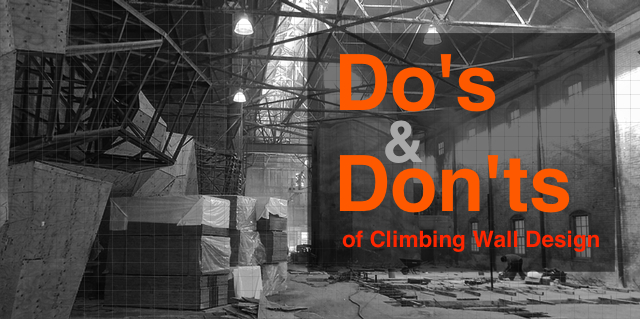
Apart from the cost of constructing a building, climbing walls are the most expensive and complicated component of a new climbing gym. To determine how you can avoid the most common mistakes, pitfalls and stresses of building a climbing wall at your facility, we reached out to all the major US wall builders to compile a comprehensive list of do’s and don’ts for climbing wall design.
Selecting a Wall Builder & Product
There are a number of professional climbing wall builders (see complete listing) that offer a wide variety of climbing wall products. To ensure that you pick the best builder for your project follow these tips:
- Work with a builder to identify product feasibility before making a final decision on a building.
- Take time to weigh the benefits and limitations of each wall type (see list of pros/cons of different wall types) and see what fits best with your long-term business strategy.
- Make sure to call references and ask about their experience with particular wall products and builders.
- Ensure that your wall builder and general contractor have coordinated to create a realistic construction schedule.
- Don’t choose a climbing wall product solely based on price – look at the total value of the product and the business partnership.
- Ensure that your project team has a good understanding of all local permitting requirements (structural, fire, earthquake, etc).
- Don’t skimp on the quality of your wall’s wood and t-nuts (pound-in vs screw-in). You will regret cheap materials.
Designing your Climbing Wall
Once you have selected your wall builder, it’s time to design the wall. This is the fun part, but to ensure that your imagination doesn’t carry you away, keep these rules in mind:
- Don’t design your wall before you have secured your space and have building drawings. It is a waste of your money and everyone’s time.
- Don’t cram as much climbing terrain into your gym as you possibly can. Make sure you leave adequate space for walkways and fall zones. This is essential for safety and traffic flow, and will allow staff members to more easily monitor the facility.
- Make sure you have a clear understanding of your target customers, and use this to drive your product and terrain choices. In most markets the majority of climbing terrain should be oriented to beginner and intermediate climbers.
- Don’t design a wall that you really want to climb, but that sacrifices the maximize utility of your facility. The taller your walls are, the fewer climbers can use the wall each day (taller walls equal longer time on the wall). Likewise, the more steep and lead climbing terrain you have means less terrain for your average climber.
- Make sure your design includes flat open planes that will allow routesetters maximum flexibility.
- Don’t forget to budget for a safe and durable flooring system – your walls are useless without it.
- Don’t overlook the non-climbing spaces. A well designed lounge area promotes a social environment and gives people a nice place to congregate when they are not climbing.
You will find more advice and a FAQ about climbing walls on our Climbing Wall Directory. This article and the climbing wall resources page would not be possible without the knowledge and support of Eldorado, Walltopia, Elevate, Louie Anderson and Rockwerx.

Climbing Business Journal is an independent news outlet dedicated to covering the indoor climbing industry. Here you will find the latest coverage of climbing industry news, gym developments, industry best practices, risk management, climbing competitions, youth coaching and routesetting. Have an article idea? CBJ loves to hear from readers like you!






